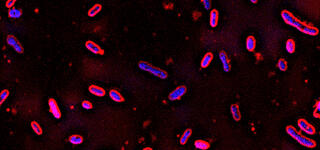Biological funneling of aromatics from chemically depolymerized lignin produces a desirable chemical product

Engineered Novosphingobium aromaticivorans funnels heterogeneous mixtures of lignin depolymerization products to a potential polyester precursor
The Science
Lignin is an abundant but tough polymer found in plant biomass. Breaking down lignin, whether through biological or chemical means, invariably produces heterogenous mixtures of low molecular weight aromatic (ring-containing) compounds. Microbes that can metabolize lignin-derived aromatics have evolved pathways that funnel these heterogeneous mixtures into a few common intermediates, which simplifies further processing. Scientists at the Great Lakes Bioenergy Research Center engineered Novosphingobium aromaticivorans DSM12444 to convert multiple lignin-derived aromatics into a single chemical called 2-pyrone-4,6-dicarboxylic acid (PDC), a potential precursor for making polyester, epoxy adhesives, and other bioplastics.
The Impact
This work represents a valuable advance in using bacteria to funnel mixtures of aromatic compounds into defined single commodities. It also shows that N. aromaticivorans could be an ideal microbial platform for valorization of lignin and other plant-derived aromatics. Ultimately, the information and strategies developed here and in future optimization of PDC production by N. aromaticivorans may help engineer this and other microbes to produce a wide range of additional valuable compounds from lignin.
Summary
Despite recent advances in plant biomass deconstruction and lignin depolymerization strategies, the heterogeneity of resulting product mixtures presents a major challenge for conversion into commodity chemicals. In this work, Great Lakes Bioenergy Research Center scientists created a defined set of mutations in the central aromatic catabolic pathways of N. aromaticivorans DSM12444. This engineered strain was able to simultaneously convert the three major types of plant-derived aromatic compounds (those containing syringyl (S), guaiacyl (G), and p-hydroxyphenyl (H) aromatic units) into PDC.
In batch cultures containing defined media, the engineered strain converted several of these depolymerization products, including S-diketone and G-diketone (non-natural compounds specifically produced by chemical depolymerization), into PDC with yields ranging from 22% to 100%. In batch cultures containing a heterogeneous mixture of aromatic monomers derived from chemical depolymerization of poplar lignin, 59% of the measured aromatic compounds were converted to PDC. Overall, the results show that N. aromaticivorans has ideal characteristics for its use as a microbial platform for funneling heterogeneous mixtures of lignin depolymerization products into PDC or other commodity chemicals.
Program Manager
N. Kent Peters
kent.peters@science.doe.gov, 301-903-5549
Corresponding Author
Daniel R. Noguera
dnoguera@wisc.edu
Funding
This work was supported by U.S. Department of Energy (DOE) Great Lakes Bioenergy Research Center grants (DOE Office of Science BER DE-FC02-07ER64494 and DE-SC0018409) and a fellowship from the Chilean National Commission for Scientific and Technological Research (CONICYT).
Publications
Perez, J. M. et al. “Funneling aromatic products of chemically depolymerized lignin into 2-pyrone-4-6-dicarboxylic acid with Novosphingobium aromaticivorans.” Green Chemistry (2019) [DOI: 10.1039/C8GC03504K].
Related Links
https://pubs.rsc.org/en/content/articlelanding/2019/gc/c8gc03504k#!divAbstract
https://news.wisc.edu/engineered-microbe-may-be-key-to-producing-plastic-from-plants/